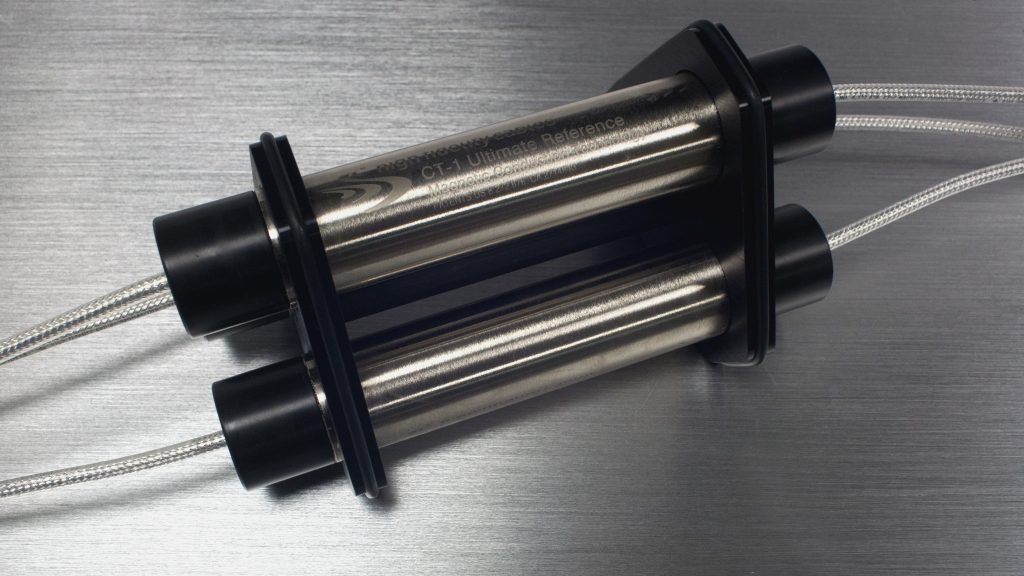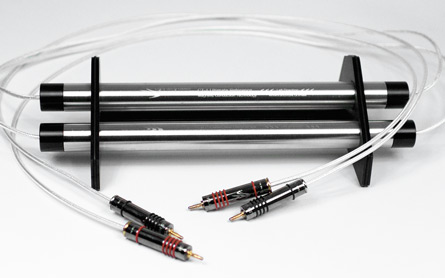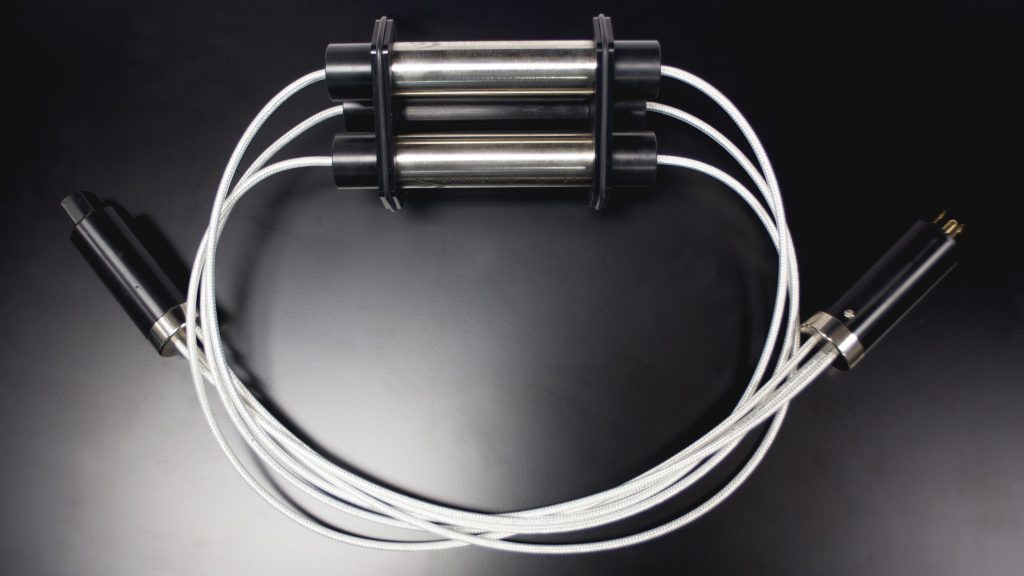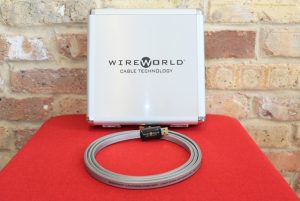Few cable manufacturers had the kind of rookie effort Rick had with his first company, Virtual dynamic, in the early 2000s. Like his initial approach, Rick continues to have an unwavering commitment to the use of high powered magnets that surrounds the wire the signal passes through. Rick has several patents, and plenty of data to back up his assertions that his approach deals with important aspects of avoiding the corruption of an audio signal.
The ultra stiff construction of the VD wire was made even more challenging by the prospect of getting your fingers caught between the angry, unrelenting snapping of the magnets coming together when brought into close proximity to each other. Physical dangers and practical issues aside, the results of Rick's efforts were singular. Music came through as if a turbo charger had kicked in. Dynamics became intense, slam, speed, and impact made most of the cables I had heard previously sound quite boring and flat. These cables did nothing but make a hell of an impression, though some found the effect polarizing (sorry). As would happen for a reviewer, time marched on and other products would fill my queue, but my memory of the Virtual Dynamics cable's unique qualities have lingered.
When my Editor Dave Clark asked if I could do him a solid and give Rick's new High Fidelity Cables a listen, I felt uniquely experienced to document Rick's progress over the years, and hear for myself what he has been up to and where the commitment to the application of magnets has led. For a full breakdown of the Technology Rick employs, known as magnetic induction, visit his website highfidelitycables.com
The top of the line CT-1 Ultimate Reference Helix, CT-1URH for short, speaker wire, ICs, and power cords are no longer as stiff as a Brooklyn Bridge support cable like the Virtual Dynamics. And the magnets are now located mid-run in long round metal casings rather than at the ends of the cable. The wire itself is quite thin and springy with buttresses holding the heavily shielded magnets in place. One quibble is the protective rubber bumper o-rings surrounding the edges of the end pieces that hold the magnets in place tend to pop out of the shallow ridge rather easily, and really should be permanently affixed during factory construction, especially at this price point. Other than that the CT-1URH posed no issues and performed without any hiccups.
My system consists of the PassLabs XA200.5 class A mono blocks sitting on the stunning Italian Bassocontinuo carbon fiber and leather clad stands, the D'Agostino Momentum preamplifier and Momentum phono stage, a McIntosh MB50 streamer/DAC, and the VPI Avenger Reference turntable. Speakers were the Lansche 4.1, the GoldenEar Reference, and the Sunny Cable Majestic15.
The CT-1 URH speaker wire is $20,900 per meter ($1200 for each additional 1/2 meter). The CT-1 URH XLR IC is $20,640 ($720 per additional 1/2 meter), and the CT-1 URH Helix power chord is $12,900 ($875 per additional 1/2 meter). In this class there is some stiff competition from MIT, Transparent , Nordost, and Crystal cable, just to name a few. For the last few years the MIT Oracle ACC169 speaker interface ($44,990) and MA-X HD proline XLR IC's ($21,990) have proven to be best I have ever heard. The MIT Zpower power chords are $1200 compared to the $12,900 CT-1URH power chords making up the price disparity in the speaker interface bringing both systems into relative alignment price wise.
Before I go on, I want to make clear this is not a cable "shoot out." I hate that term, and with products at this level, most of the differences are subtleties that results in more of a preference rather than one "blowing the other away," another term you will never hear me mutter.
Comparing the CT-1 URH and the MIT is much like comparing two very high end sports cars. For discussion's sake, lets go with a McLaren 720S and a Ferrari 488GTB. Both manufacturers have very specific philosophies guiding the design of their cars. These two cars have very similar specs, yet offer good contrast. On paper, at least, they overlap quite a bit, but behind the wheel, they offer different, but valid, invigorating driving experiences. The McLaren is very precise with laser focus, blinding speed, intense braking power coupled to very quick steering response. The Ferrari, while .2 seconds slower to 60 mph, is perhaps a bit more organic and colorful, and has more personality and road feel. The Ferrari and McLaren are very similar in price as are the HFC and MIT, so distilling it down, the CT-1URH is the McLaren and the MIT is the Ferrari.
The CT-1URH has expanded the sonic pallet significantly from the old Virtual Dynamics, though the core strengths remain in the forefront. The CT-1URH brings a system to life with effortless power delivery, blazing acceleration if you will, and a lack of coloration that is stunning. Textures are super clean, backgrounds are sublimely black, yet alive with reverbs, echoes, jazz clubs... and concert hall ambience abound. Most wire compared to the CT-1URH sounds like it's holding something back, closing something in. The CT-1URH is totally untethered to any sense of restriction or compression. Music simply breathes and expands with utter ease. This quality is like the McLaren's acceleration and cornering; point and shoot driving at its best. Despite very close 0-60 times, the McLaren gobbles up the road with acceleration in a very specific way, with precise chest crushing speed. The Ferrari is about the roar and whine of the engine and a connection to the road which enhances the experience. Like the Ferrari the MIT feels a bit enhanced by saturation of color and body. There is a presence with the MIT that is very solid and tactile... like the road feel and feedback through the steering wheel the Ferrari provides. Of course, if I could, I'd own both cars and both sets of cable.
The CT-1URH tends to highlight the action of the instrument, the point where the air escapes the bell of a sax for instance. There is a laser like focus to resolving these subtle low level cues buried in the mix. The CT-1URH is vivid without ever being overly bright or edgy. It is however, in the high frequencies, where the MIT and CT-1URH converge a bit. Both are exceedingly clean and loaded with detail. The reader could see the last sentence in any cable review, but here the sheer quantity of recorded information and the effortless manner by which it is rendered is amazing, and both are clearly state of the art. The CT-1URH is a tad more linear, were the MIT a touch more organic.
As we move down into the mid and upper mid band, the two presentations differ a bit. The CT-1URH has a great feeling of precision and microscopic levels of detail. It's not that the CT-1URH is lean, analytical, or threadbare at all, far from it actually. It is a touch more forward in perspective than the MIT and creates a great feeling of action and intimacy in the music with ultra-clean transients and very fine dynamic shading. The MIT again favors instrumental color and body with less emphasis on transients, though there is no sign of transient blunting or blurring with the MIT despite the fact it does not accentuate them. Vocals through the CT-1URH are great, really great. The resolution makes for an incredibly believable and intimate connection with the music. Eva Cassidy's "Stormy Monday," from Live at Blues Alley, lit up beautifully with her vocals coming to life in a fresh and exciting manner. In a totally believable way, the CT-1URH captures the perspective of reality from a slightly different perspective than the MIT. With the CT-1URH I'm more aware of a recording's production qualities and space, where the MIT emphasizes timbre and textured tonal qualities of the instrument. These differences are not huge, but they are there.
Like Rick's earlier efforts, the bass and overall dynamics of the CT-1URH are excellent. The bass is solid and unrestricted in depth, and provides outstanding definition. But here comes that pesky Ferrari growing in the rear view mirror. The MIT sounds a bit more integrated from the low bass into the mid bass and lower mid band. The CT-1URH definition in this range is sculpted and dense, which is great, but there is less bloom from a stand up bass for instance that fills the gaps with harmonics, focusing more on the notes fundamentals. Where the MIT offers a touch more bloom. Bass dynamics are as unique as they were with the earlier Virtual Dynamics. There is a propulsive thrust that the CT-1URH has that is very engaging. Music jumps and swings baby! Some of my metal chestnuts like "The Infection" from Disturbed Asylum was awesome. Late in the review I reinstalled my Sunny Cable Majestic15 speakers as my time with the fantastic new GoldenEar Reference came to an end. The GoldenEar Reference powered sub drivers were massively gripped, and drove me to near madness. The Sunny Majestic are 600 lb monsters, and have a 15 inch woofer per side that crosses over into a horn driver at 500Hz, and is capable of extreme sound pressure levels. There was nowhere to hide in my 4000 sq. ft. loft from all the mayhem. This was all great fun for me, but it scared the crap out of my cat.
Sound staging with the CT-1URH is super wide and precise, a bit more forward than the MIT, with both having exceptional depth. Both resolve images vividly, whether front and center, pinned to the back of a concert hall, or floating in a synthetic soundscape conjured by a producer. There may be a bit more image dimension with the MIT, again due to the densely colored and fleshy rendering. But the CT-1URH lights up the space around images in a way that is very live feeling.
As I stated earlier, this was not a shoot out. This was a compare and contrast of two exceptional ultra high end products, both worthy of the highest praise. The MIT will remain my reference, as they reveal certain qualities I value, but another listener could easily go the other way depending on system synergy and sonic priorities. The CT-1 URH are so low in distortion and so clean they had me wondering if the MIT's edge came from some form of distortion, but I could not draw that conclusion and still sleep well at night. The fact that I had to slice the onion as thin as I did making these observations is a testament to the CT-1 Ultimate Reference Helix products. They really performed well, presented the music in totally valid if different way than the MIT.
With the CT-1 Ultimate Reference Helix line, Rick Schultz has earned his seat at the big boys table. His unique, singular approach to transmitting an audio signal represents the pioneering spirit that high end audio has been built upon. These products are clearly state of the art, and definitely need to be reckoned with. I totally respect the kind of creativity Rick has applied to his designs and the greatly admire the performance his High Fidelity CT-1 Ultimate Reference Helix cables delivered.
Prices are noted in the review.
High Fidelity










































